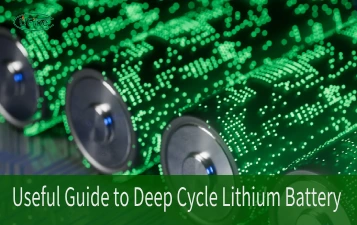Part 1. What is LiFePO4 battery voltage?
The electrode potential determines the voltage of a lithium battery. Voltage, also known as potential difference or potential difference, is a physical quantity that measures the energy difference between charges in an electrostatic field due to different potentials.
The electrode potential of lithium ions is about 3 V. The voltage of lithium batteries varies with different materials. For example, the rated voltage of a general lithium battery is 3.7 V, and the fully charged voltage is 4.2 V. The rated voltage of a lithium iron phosphate battery is 3.2 V, and the total voltage is 3.65 V. In other words, the potential difference between the positive and negative electrodes of lithium batteries in practice cannot exceed 4.2 V. This requirement is based on material and use safety.
The nominal voltage will vary Depending on the lithium battery pack’s cathode material. The nominal voltage of a lithium cobalt oxide battery is 3.7 V. The nominal voltage of a lithium manganate battery is 3.8 V. The nominal voltage of lithium batteries made of lithium-nickel-cobalt-manganese ternary material is only 3.5-3.6 V. However, with the continuous improvement of the formula and the improvement of the structure, the nominal voltage of lithium batteries of this material can reach 3.7 V. Lithium iron phosphate battery has the lowest nominal voltage, only 3.2 V.
The nominal voltage of the LiFePO4 battery is 3.2 V, the high-end charging voltage is 3.65 V, and the low-end discharge voltage is 2.0 V. Due to the different quality and process of the positive and negative electrode materials and electrolyte materials used by various battery manufacturers, their performance will be different.
Lithium iron phosphate batteries have the advantages of high safety, long cycle life, rate discharge, and high-temperature resistance. They are considered to be a new generation of lithium batteries. It can be applied to power energy storage, special equipment, robots, AGVs, rail transit, medical equipment, emergency equipment, power communications, etc.
LiFePO4 battery features
- Excellent safety performance: No explosion or burning when punctured or overcharged.
- Superior cycle life: LiFePO4 batteries can exceed 2,000 cycles.
- Outstanding high-temperature performance: Operates within -20 °C to 70°C range.
- High tap density and increased capacity in comparable conditions.
- Enables rapid charging at 1C-5C rates, significantly reducing charging time.
1. 3.2 V LiFePO4 battery
3.2V lithium iron phosphate battery refers to the nominal voltage of the battery cell. That is, the average voltage from the beginning to the end of discharge (the voltage we often say is dead) after the battery cell is fully charged.、
2. 3.65 V LiFePO4 battery
As for 3.6 voltage refers to the no-load voltage of the lithium iron phosphate battery when it is fully charged. In other words, these two voltages refer to the voltage of the battery core. The single-cell voltages of similar batteries are the same, but the capacity is different. The battery capacity depends on the cell size, specifications, equipment, and R&D technical strength of the lithium iron phosphate battery manufacturer. Strong lithium battery manufacturers, such as Ufine, can produce lithium iron phosphate batteries of the same size and specifications with higher capacity. Still, of course, the price will be more expensive.
3. 12 V, 12 V, 24 V, 72 V LiFePO4 battery
So what are the 12 V, 12 V, 24 V, and 72 V of lithium iron phosphate batteries? The statement that the voltage exceeds 3.65 refers to the battery, not the cell. Whether it is 12 V, 24 V, or higher LiFePO4 voltage, it is all achieved through the series connection of battery cells. For example, 12 V requires four 3.2 V battery cells to be connected in series, which is 3.2 V+3.2 V+3.2 V+3.2 V= 12.8 V.
Part 2. LiFePO4 battery voltage and capacity
LiFePO4 Battery Voltage
As mentioned, the nominal voltage of a single lithium iron phosphate battery is 3.2 V, the charging voltage is 3.6 V, and the discharge cut-off voltage is 2.0 V. The lithium iron phosphate battery pack reaches the voltage the equipment requires through the series combination of cells. The battery pack voltage = N * the number of series connections. Commonly used lithium iron phosphate battery pack voltages are as follows:
– 12 V LiFePO4 Battery
– 24 V LiFePO4 Battery
– 36 V LiFePO4 Battery
– 48 V LiFePO4 Battery
– 72 V LiFePO4 Battery
LiFePO4 Battery Capacity
The capacity of the lithium iron phosphate battery pack is determined based on the capacity and number of cells connected in parallel. It is generally determined based on the specific requirements of the electrical equipment. The more LiFePO4 cells connected in parallel, the greater the capacity. Common LiFePO4 battery pack capacities include 10ah, 20ah, 40ah, 50ah, 100ah, 200ah, 400ah, etc.
Part 3. LiFePO4 voltages and battery life
1. Charge and discharge
When choosing a battery charger, it is best to use a charger with a correct termination device to cut off the charge to avoid shortening the service life of the lithium iron phosphate battery due to overcharging. Generally speaking, slow charging can extend the battery’s life better than fast charging.
2. Discharge depth
The depth of discharge is the main factor affecting the life of lithium iron phosphate batteries. The higher the depth of discharge, the shorter the life of the lithium iron phosphate battery. In other words, as long as the depth of discharge is reduced, the service life of lithium iron phosphate batteries can be greatly extended. Therefore, over-discharging lithium battery UPS to extremely low voltages should be avoided.
3. Working environment
Suppose lithium iron phosphate batteries are used at high temperatures for a long time. In that case, their electrode activity will decay, and their service life will be shortened. Therefore, maintaining a suitable operating temperature is a good way to extend the life of lithium iron phosphate batteries.
Part 3. Final thoughts
There are many kinds of LiFePO4 battery voltages. The capacity of a LiFePO4 battery or battery pack is ever-changing, and batteries with corresponding capacity can be made according to electrical equipment needs. Of course, the capacity of cells of a certain size is also limited. You must connect cells or batteries in parallel to increase the battery capacity. This also has a quantity limit.
Part 4. FAQs
-
What voltage should my LiFePO4 battery be?
The voltage of a LiFePO4 battery should typically be around 3.2 to 3.3 volts per cell. -
What is the safe float voltage for LiFePO4?
The safe float voltage for LiFePO4 batteries is around 3.4 to 3.45 volts per cell. -
What is the nominal voltage of a LFP battery?
The nominal voltage of an LFP (LiFePO4) battery is typically 3.2 volts per cell. -
What is the voltage variation of a LiFePO4 cell?
The voltage variation of a LiFePO4 cell can be around 3.0 to 3.6 volts, depending on the state of charge. -
What is the voltage range of LiFePO4 batteries?
The voltage range of LiFePO4 batteries is generally between 2.5 and 3.6 volts per cell, covering the discharged and fully charged states.
Related Tags:
More Articles

Overview of Deep Cycle Lithium Battery
In this article, we explore the life, voltage, capacity, and charging considerations of deep cycle lithium batteries.
How Long do Lithium Batteries Last?
How long do lithium batteries last? we will explore the factors that influence the lifespan of lithium batteries and provide insights into their longevity.
How to Choose the Best LiFePO4 Battery?
Choose LiFePO4 batteries for superior performance, safety, and versatility in EVs, UPS, and backup power. This guide helps you make informed decisions.
Get 12v Lithium Car Battery As a Power Source for the Ride
Make the right choice for your vehicle's battery needs by installing a 12 volt lithium car battery. You will enjoy maintenance-free longevity with this change.
Everything About A Small Lithium Ion Battery
Discover the features, uses & future potential of a small lithium ion battery. A compact and tiny powerhouse ideal for smartphones, wearables, drones & more.




